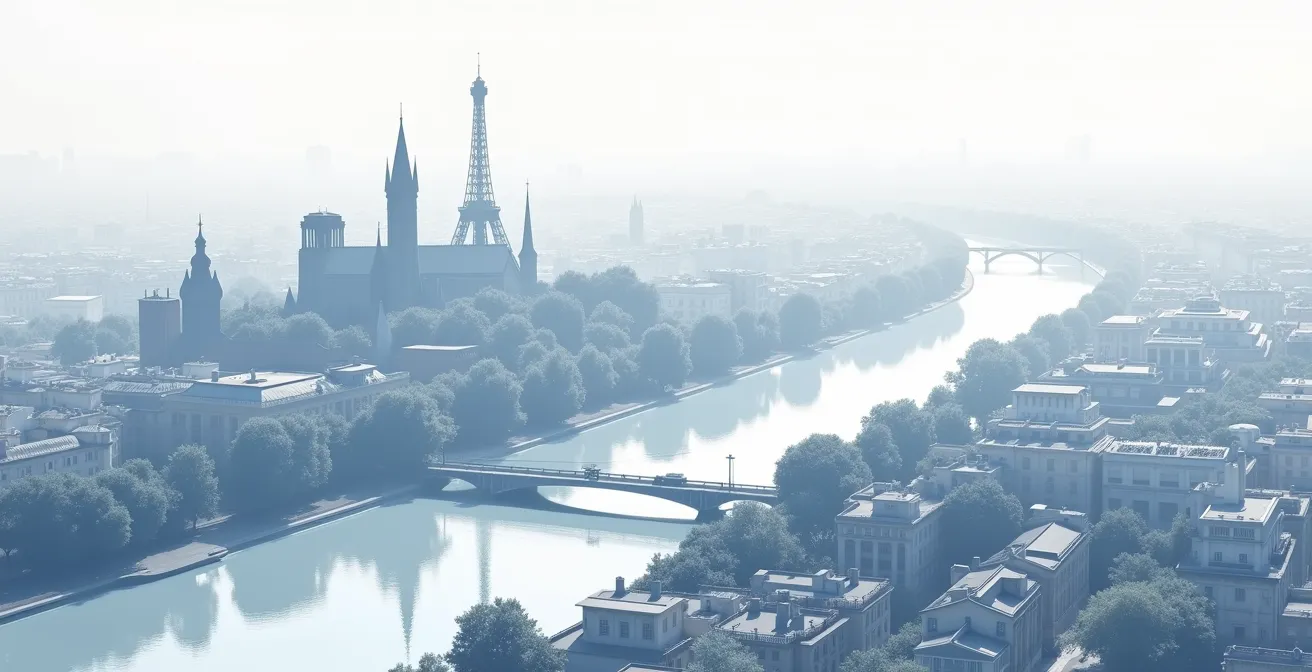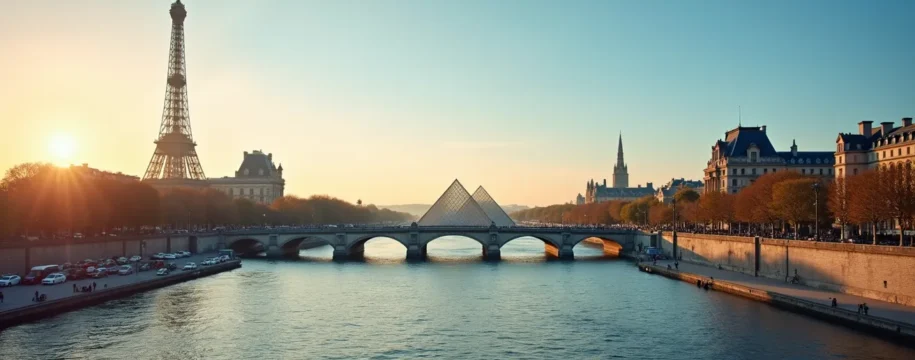- Use the River as a Highway: Swap the crowded Metro for the Batobus (water bus) to connect major monuments seamlessly.
- Adopt the 'Hub and Spoke' Model: Use each Batobus stop as a hub for short, targeted walking tours to nearby attractions.
- Build Your 'Efficiency Stack': Combine transport passes, museum passes, and booking apps into a single, powerful system.
- Cluster Your Sightseeing: Group monuments geographically to minimize travel and maximize your time at each location.
Forget the Metro: Unlock Paris with the Seine River 'Highway' Strategy
The first step to unlocking an efficient Parisian adventure is to re-evaluate your primary mode of transport. The Batobus, or water bus, is often mistaken for a simple tourist cruise, but its true value lies in its function as a strategic transport artery. It directly connects key monuments along the Seine, effectively eliminating traffic jams, navigation stress, and the cognitive load of deciphering metro maps. This approach is built on the "Hub and Spoke" model. Think of each Batobus stop (like the Louvre, Eiffel Tower, or Notre-Dame) as a central "Hub." From there, you execute short, focused walking "Spokes" to explore nearby attractions. This method drastically reduces walking fatigue and eliminates the wasted time and missed scenery associated with underground travel. User experiences often highlight it as a pleasant way to combine sightseeing with mobility, turning what would be stressful transit into a scenic journey.What is the "Hub and Spoke" sightseeing model?
It's a strategy where you use a central transport point (the "Hub," like a Batobus stop) as a base to explore multiple nearby attractions via short walks (the "Spokes"), minimizing travel time and fatigue.
This strategy isn't just about the view; it's about a fundamental shift in how you move through the city. The visual below conceptualizes how the river becomes a central spine, with monuments branching off, turning a chaotic map into an organized, linear path. By using the river as your guide, you create a natural itinerary that flows from one major landmark to the next. This approach is not only more relaxing but also more sustainable, as river transport consumes 4 times less energy than land-based alternatives, aligning your travel with a lighter environmental footprint.The Seine offers an exceptional panorama and an enriching experience, far from the urban tumult of underground transport.
– Batobus (Official Paris River Service), Official Batobus Practical Information
Build Your 'Efficiency Stack': The Toolkit for a Seamless Experience
An effective strategy requires the right tools. The "Efficiency Stack" is not just a list of tips but a pre-selected combination of passes and apps that work together to eliminate friction at every stage of your visit. It’s a system designed to give you back your most valuable asset: time. The core components of this stack are designed to address the biggest time-sinks: transport, ticketing, and navigation. These include the Batobus Pass for fluid river travel, the Paris Museum Pass for skipping ticket lines at most major museums, an offline map application like Google Maps for confident "spoke" walks without relying on data, and a reservation app or website for booking mandatory time slots at hyper-popular venues.| Component | Paris Museum Pass | Batobus Pass | Google Maps Offline | Eiffel/Louvre Reservation |
|---|---|---|---|---|
| Cost (per day) | €35-55/day | €17-28/day | Free | €14.50-22€ |
| Attraction Access | 50+ museums/monuments | 9 river stops | Offline navigation | Priority access |
| Skip-the-line | Yes (most sites) | N/A | N/A | Yes (essential) |
| Time Savings | From the 4th visit | Continuous (avoids metro) | Continuous | 30-60 min saved |
Use Case: Louvre Efficiency with Online Booking
By booking in advance at the Louvre, visitors reduce waiting times from 45–135 minutes (without reservation) to under 15 minutes (with priority access). On peak days during high season (April-September), entering via the Carrousel or Richelieu entrances instead of the Pyramid saves an additional 30-45 minutes. Studies show that 96% of Louvre visitors who plan ahead report being satisfied, versus 68% of those who buy tickets on-site.Efficiency Stack Preparation Checklist
- Download Google Maps and download the Paris zones offline 2 days before your visit.
- Purchase your 24h or 48h Batobus Pass (€17-€28) and familiarize yourself with the 9 stops.
- Book your tickets for popular sites (Louvre, Eiffel Tower, Sainte-Chapelle) at least 48 hours in advance with timed slots.
- Activate the Paris Museum Pass if you plan on visiting 4+ museums/monuments.
- Plan a "spoke" of activities (5-15 min walk) around each Batobus stop.
- Check opening hours the day before (some sites close on public holidays).
- Set reminders 30 minutes before your reserved time slots so you don't miss them.
| Tool | Main Advantage | Limitations | Best for |
|---|---|---|---|
| Paris Museum Pass | Unlimited access to 50+ museums; Max savings after 4 visits | Valid for x consecutive days only | Art and culture lovers |
| Batobus | Congestion-free mobility; Continuous panoramic view | Slower journeys than metro | Time-pressed visitors wanting a scenic experience |
| Google Maps Offline | Autonomous navigation without an internet connection | No real-time data | Pedestrian wandering, neighborhood exploration |
| Advance Reservations | Skip queues (30-135 min saved) | Time slot inflexibility | Ultra-popular attractions (Louvre, Eiffel) |
Strategic Sightseeing: Clustering Monuments Around Your River Route
The "Hub and Spoke" model becomes truly powerful when you intentionally cluster your sightseeing. Instead of a random list of destinations, this method organizes Paris into manageable geographic groups centered around your river route. This transforms an overwhelming itinerary into a series of achievable mini-tours, which is critical when you consider that the top three most visited Parisian monuments attract a combined 19.95+ million annual visitors. By focusing on one cluster at a time, you spend more time inside monuments and less time in transit. The visual below illustrates this concept, showing how major landmarks naturally group together around the Seine.
Case Study: The Île de la Cité Cluster Optimization
The Île de la Cité concentrates 4 major attractions within 400m of each other: Notre-Dame (reopening Dec 2024), Sainte-Chapelle, the Conciergerie, and the Archaeological Crypt. A visitor can explore this cluster in 3-4 hours on foot, arriving via a single Batobus stop (Hôtel de Ville). Combined with a 2-day Museum Pass, the total cost per person is ~€70-90 for unlimited, skip-the-line access to these sites, averaging ~€18-23 per attraction—well below individual ticket prices.- Treat the Seine as a "transport highway" with the Batobus to avoid traffic and metro crowds.
- Use each river stop as a "hub" for short walking tours to clustered monuments ("spokes").
- Combine passes (transport, museum) and reservations into an "efficiency stack" to eliminate queues.
- Focus on the "First In, Last Out" principle: visit top sites at opening or just before closing.
- Leverage secondary attractions to enjoy world-class culture while others are waiting in line elsewhere.
Mastering Entry: Advanced Tactics for Beating the Crowds
The final layer of efficiency is mastering the art of entry. Going beyond the basic "buy tickets online" advice means understanding the crucial difference between a pass (like the Paris Museum Pass) and a mandatory timed-entry reservation. For venues like the Louvre, you often need both—the pass for payment and a separate (often free) reservation to secure your entry slot. Failing to book this slot can render your pass useless during peak times, as advance booking reduces wait times to under 15 minutes compared to 45–135 minutes without one. Next, apply the "First In, Last Out" principle. For the most popular monuments, your goal should be to arrive for the very first entry of the day or within the last 90 minutes before closing. These time windows consistently have significantly smaller crowds, allowing for a more intimate and enjoyable experience.Understanding the flow of crowds throughout the day is essential for strategic planning, especially at choke-points like the Eiffel Tower, where wait times can vary dramatically.The best visibility is obtained 1 to 2 hours before sunset. During the day, crowds at the Eiffel Tower are generally smaller before 11 a.m. and after 8 p.m.
– La Souris Globe-Trotteuse, View from the top of the Eiffel Tower: visiting tips, photos & practical info
| Time Slot | Crowd Level | Estimated Wait Time (without reservation) | Recommendation |
|---|---|---|---|
| 9:00 AM - 11:00 AM | High (Max in high season) | 1-2h | Avoid unless reserved |
| 11:00 AM - 5:00 PM | High (Max in high season) | 2-3h | Avoid at all costs |
| 5:00 PM - 8:00 PM | Medium to High | 1-2h | Acceptable with reservation |
| 8:00 PM - 10:30 PM | Low to Medium | 30-60 min | Best slot for reservation |
Advanced Tactics for Beating the Queues
- 'First In, Last Out' Technique: Arrive at opening (9:00 AM Louvre, 9:30 AM Eiffel) or in the last 90 minutes before closing to experience minimal queues.
- Alternative Entrance Strategy: Avoid the Louvre Pyramid; enter via Carrousel (escalators from Palais-Royal metro) or Richelieu (arcade on Rue de Rivoli side)—saves 30-45 min.
- Museum Pass Priority: Use the dedicated entrance for pass-holders (Richelieu entrance), not the general pyramid line.
- Book 48-72h in Advance: A MANDATORY requirement for the Louvre and Eiffel Tower in high season (April-September) to secure slots.
- Secondary Attraction Advantage: While everyone queues for the Louvre, first visit the Musée Rodin or Sainte-Chapelle (same Museum Pass), which have 60-70% fewer visitors.
- Night Session Strategy: The Louvre is open until 9:45 PM on Fridays, often with 40% fewer people; the illuminated Eiffel Tower after 9 PM offers a unique experience with smaller crowds.
- Weekday vs. Weekend: Visit on Monday/Thursday/Friday; avoid Sunday and Wednesday, which can see double the crowds.
Frequently Asked Questions about Paris Sightseeing
How long does it take to visit a monumental cluster?
A compact cluster like the Île de la Cité can be explored in 3-4 hours (including queue times and museum visits). The Eiffel Tower/Trocadéro/Invalides cluster typically takes 4-5 hours.
Is it possible to visit two clusters in one day?
Yes, with the Batobus and good planning, it's very feasible. For example: Île de la Cité (morning, 3 hours) + Eiffel Tower/Trocadéro (afternoon, 3 hours) makes for a full day, with travel between them taking only 15-20 minutes by Batobus.
On which days are the clusters less crowded?
Mondays and Thursdays are generally less crowded, particularly between 9-11 AM and 3-5 PM, before the lunch and late-afternoon peaks.
Are any Batobus stops closed in winter?
No, the 9 main stops operate year-round. However, hours are reduced from November to March, typically running from 10 AM to 5 PM on weekdays and 10 AM to 7 PM on weekends.
